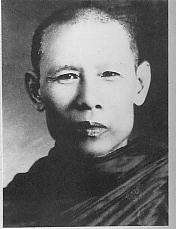Ajahn Lee
| Phra Suddhidhammaransi Gambhiramedhacarya (Lee Dhammadharo) | |
|---|---|
 | |
| School | Dhammayuttika Nikaya order of Theravada Buddhism |
| Lineage | Thai Forest Tradition |
| Dharma names | Dhammadharo |
| Personal | |
| Nationality | Thai |
| Born |
1907 Ubon Ratchathani |
| Died | 1961 |
| Religious career | |
| Teacher | Mun Bhuridatta |
| Students | Fuang Jotiko |
Phra Suddhidhammaransi Gambhiramedhacarya, (1907–1961), commonly known as Ajahn Lee Dhammadharo, was a meditation teacher in the Thai Forest Tradition of the Dhammayuttika Nikaya order of Theravada Buddhism. He was born in the Ubon Ratchathani Province of Isan and was a student of Mun Bhuridatta.
Ajahn Lee is regarded as one of the most influential Thai Forest Tradition meditation masters of the twentieth century. Among the forest monks, he devised the most comprehensive meditation instructions, and composed the most detailed map of the jhānas. He was one of the first teachers to bring the teachings of the Forest Tradition to the mainstream of Thai society.[1] Although he never spoke of his own meditative attainments, it was widely believed among his students that he was a deeply attuned psychic.[2]
Biography
Ajahn Lee first attended school at age twelve, and left school at age seventeen. At this time, he was preoccupied with earning money, and had a plan for his early life where he would earn a life savings and marry at age 30.[2]
Ajahn Lee's priorities began to change around the age of 20, when he had killed a dog who took an egg he was cooking. As he recounts in his autobiography: "Immediately, I was sorry for what I had done. ‘How on earth can I make up for this sin?’ I thought."[3] This event would motivate him to ordain as a monk.
After ordaining he reported being unsatisfied with the behavior of the monks surrounding him. The monks "played chess, held cock fights, and even ate food in the evenings."[4]
Upon meeting Ajahn Mun, Ajahn Lee reordained in the Thammayut, where he wandered the forests as a thudong, a monk who observes the dhutanga. He travelled as far as Burma, Cambodia, and India.[4]
After the rains in 1927, Ajahn Lee went back to the village where he was born (in modern-day Amnat District). As he stayed at a spirit shrine in a nearby village, his father found of his whereabouts and came and escorted him the rest of the way. When he arrived, he stayed in the villages cemetery, where the villagers refused to dwell near for fear of ghosts.[5]
Ajahn Lee stayed here for several weeks, giving sermons to people who came from other villages. Ajahn Lee got the village people to take refuge in the Three Jewels. According to Ajahn Lee, he wanted to put an end to the villagers fear of the spirits. This made some of the villagers fearful and upset, and they became opposed to him being there. When the district officer stayed one day in the village, he sided with Ajahn Lee's agenda to rid the area of spirit worship and make Buddhist practice more orthodox.[6]
References
- ↑ Strand, Clark (Spring 2011). Green Koans Case 38: Ajaan Lee Refuses to Bow. Tricycle: The Buddhist Review. Retrieved 23 September 2016.
- 1 2 Cai, p. 87.
- ↑ Dhammadharo, p. 6.
- 1 2 Cai, p. 88.
- ↑ Tiyavanich 1997, p. 205.
- ↑ Tiyavanich 1997, p. 206.
Sources
- Cai, Zhi Yun (2014). Doctrinal Analysis of the Origin and Evolution of the Thai Kammatthana Tradition with a Special Reference to the Present Kammatthana Ajahns. University of the West.
- Dhammadharo, Ajahn Lee. The Autobiography of Phra Ajaan Lee (PDF). Access to Insight.
- Tiyavanich, Kamala (1997). Forest Recollections: Wandering Monks in Twentieth-Century Thailand. University of Hawaii Press. ISBN 978-0-8248-1781-7.